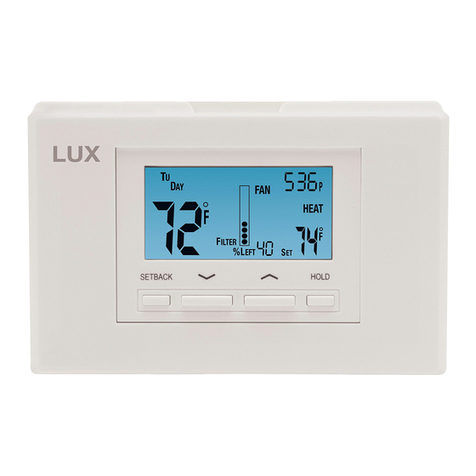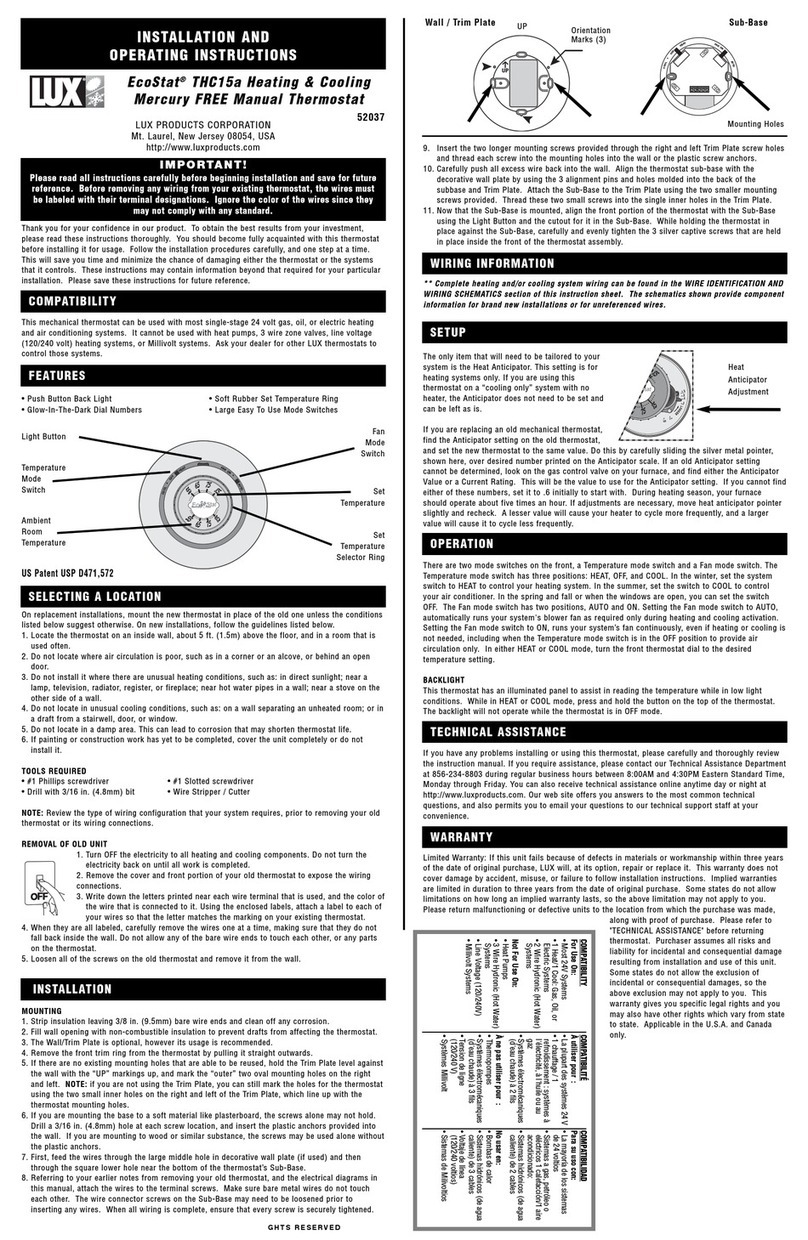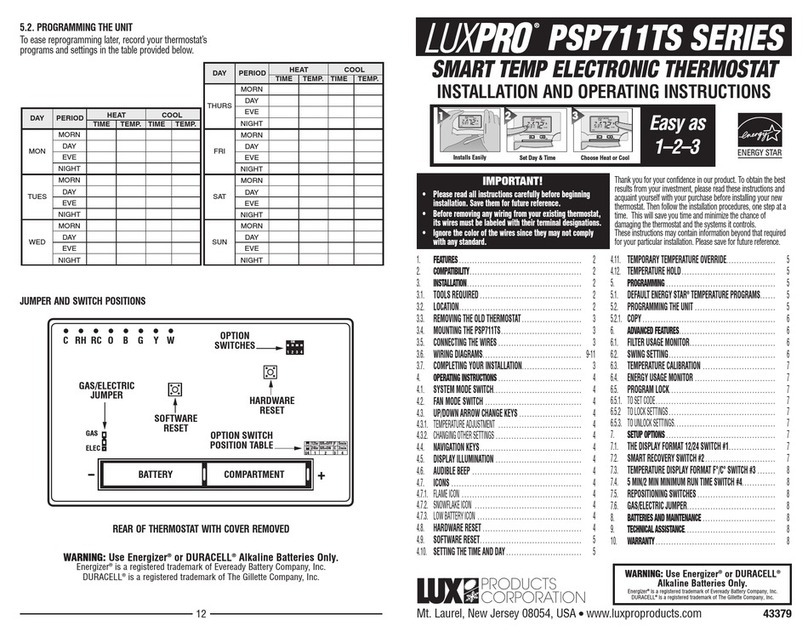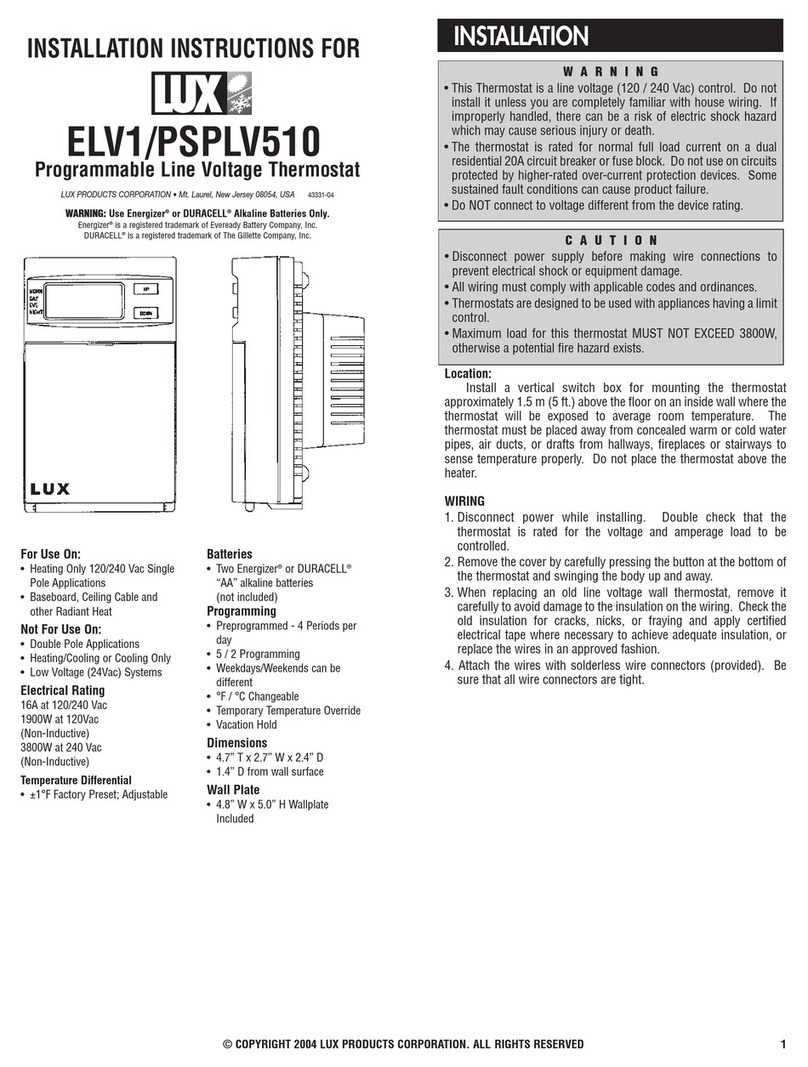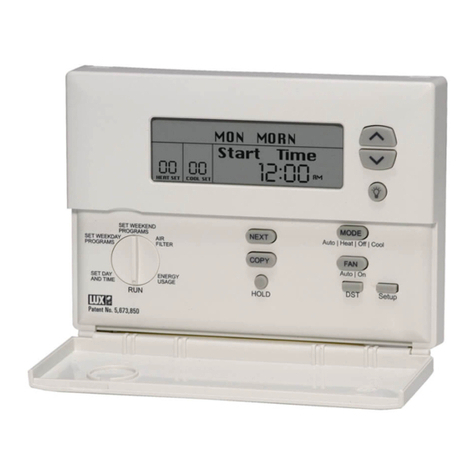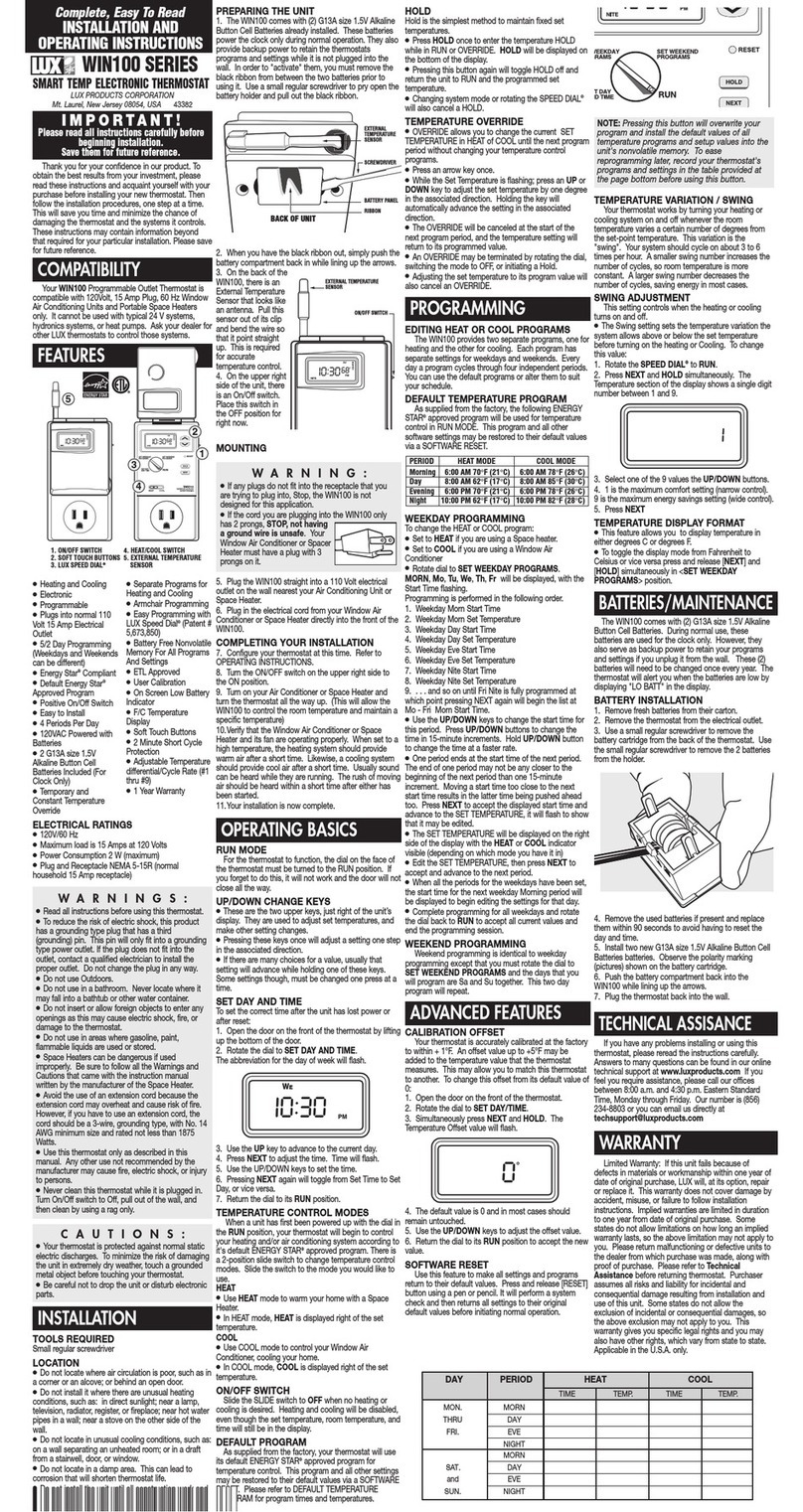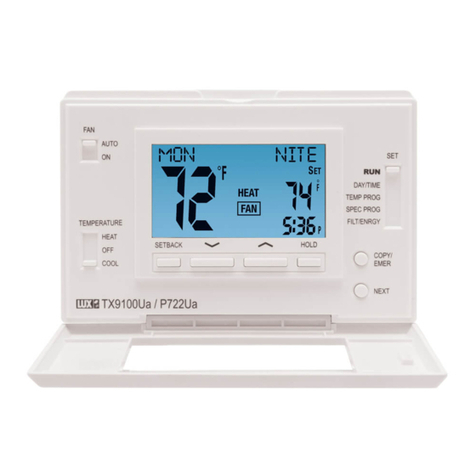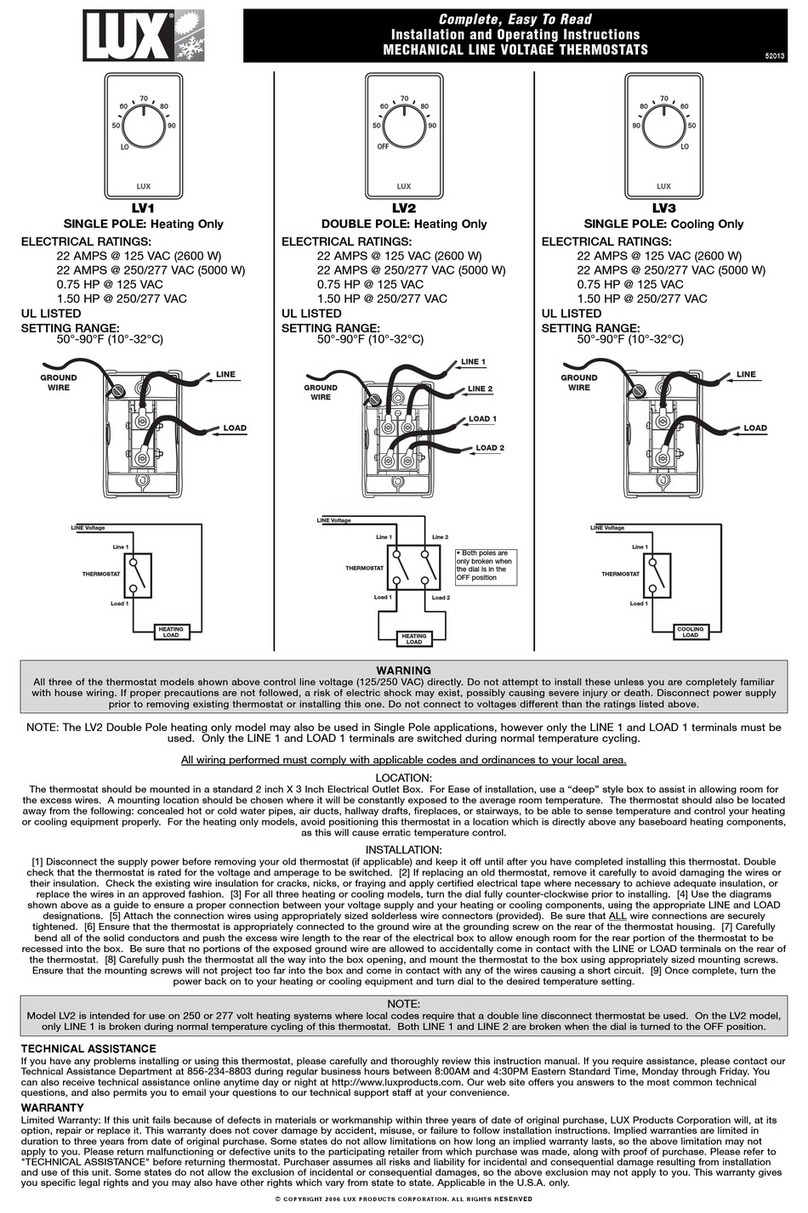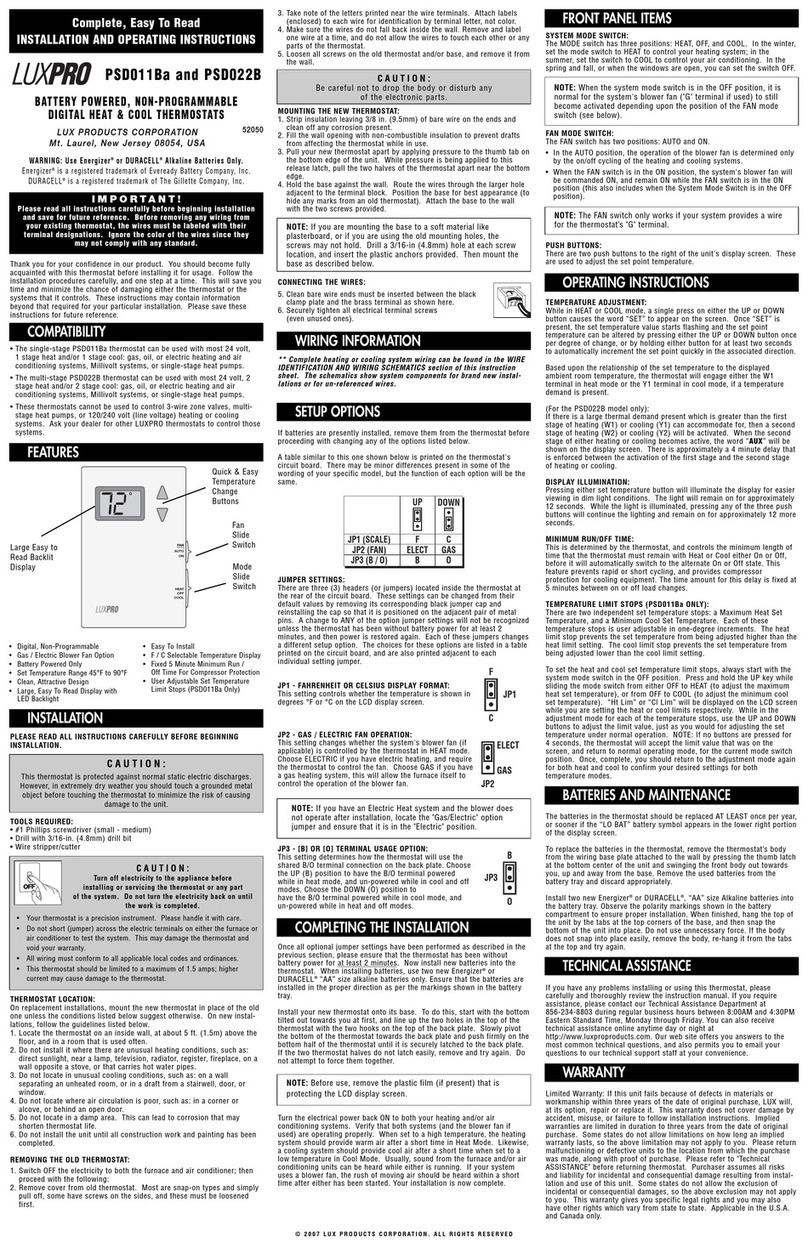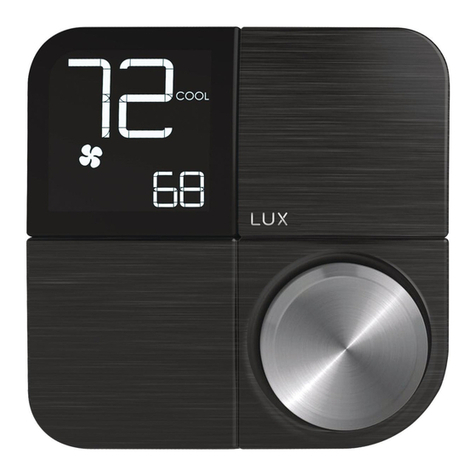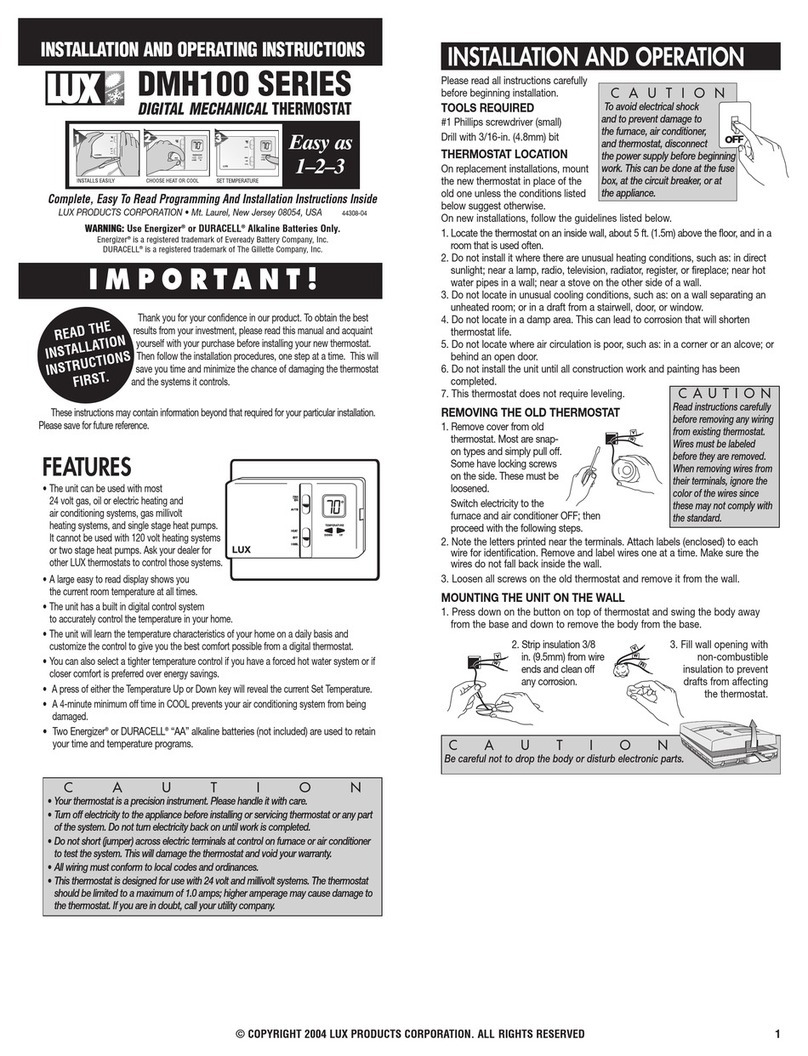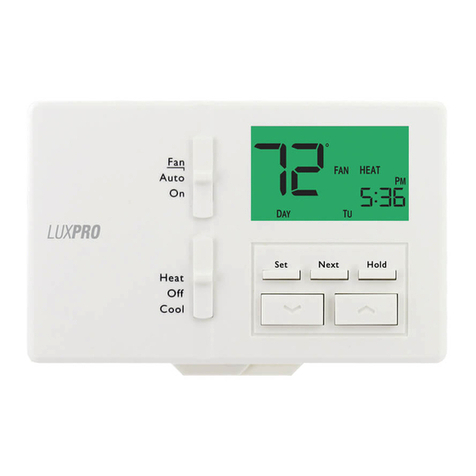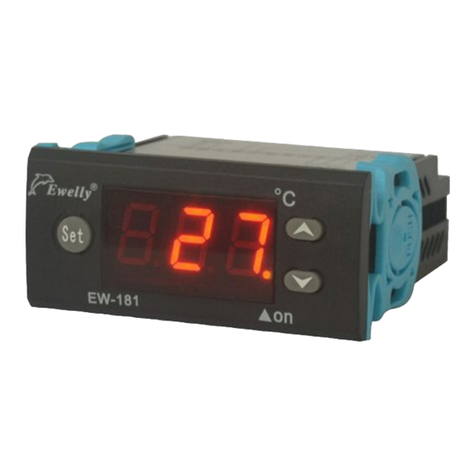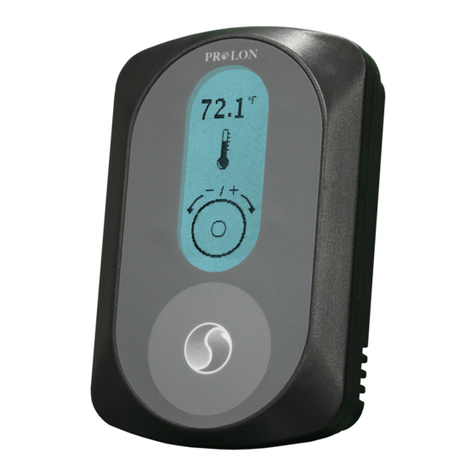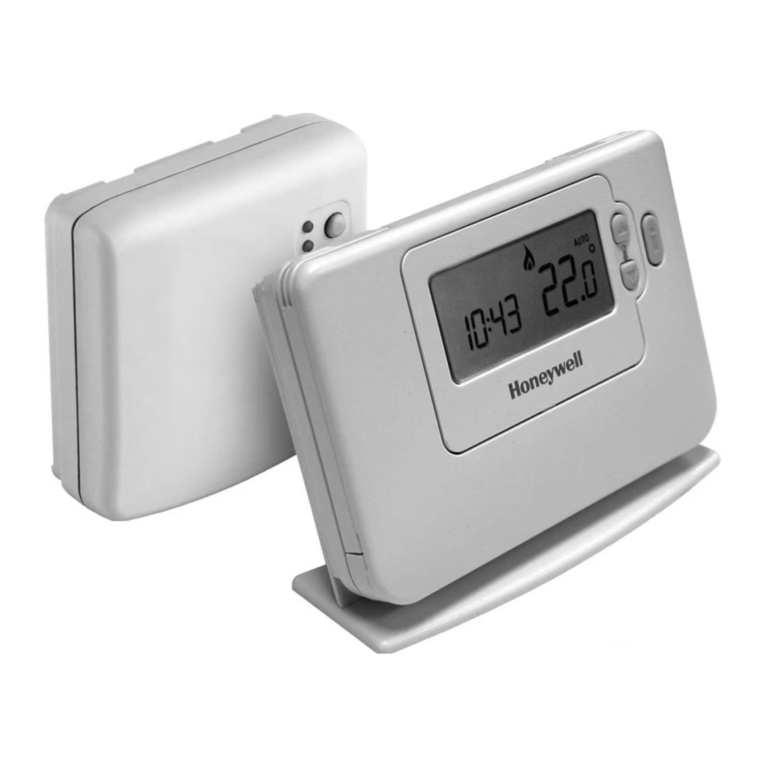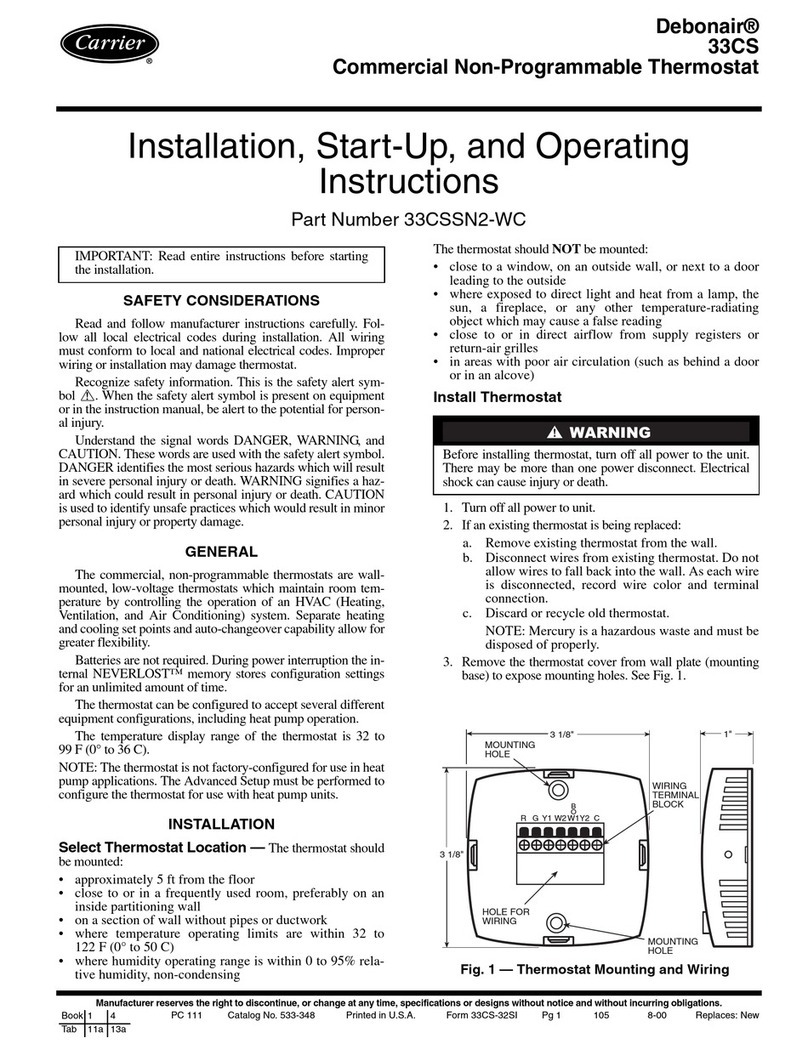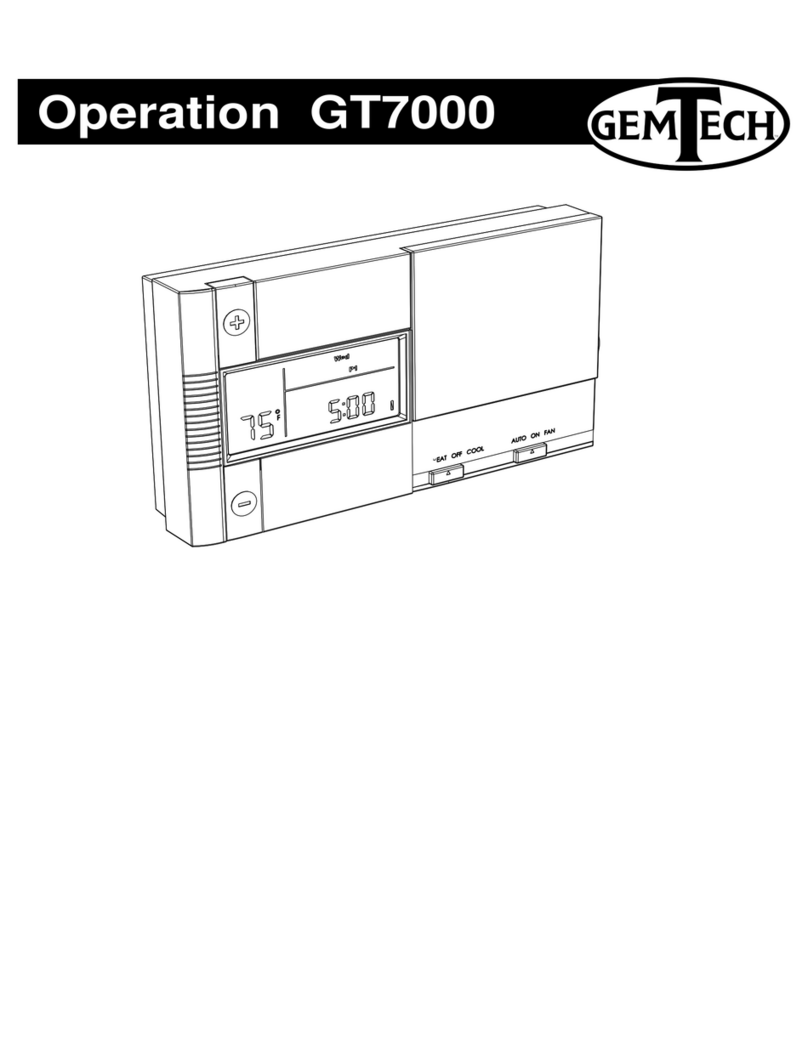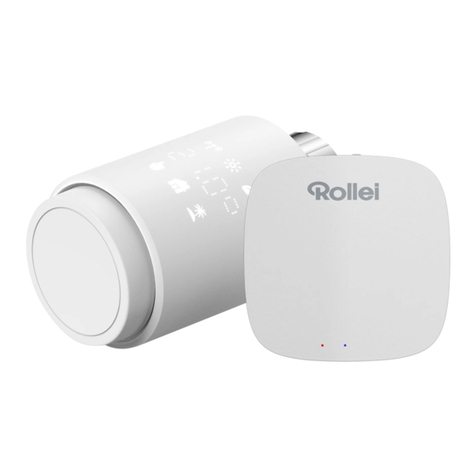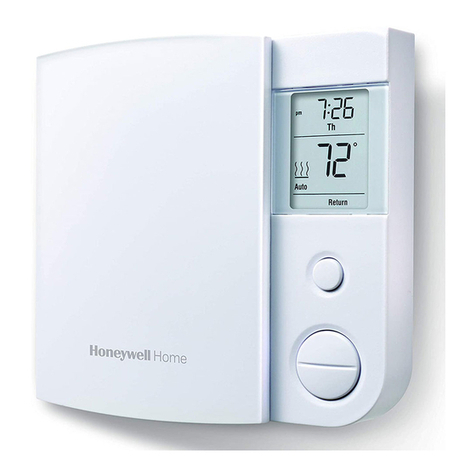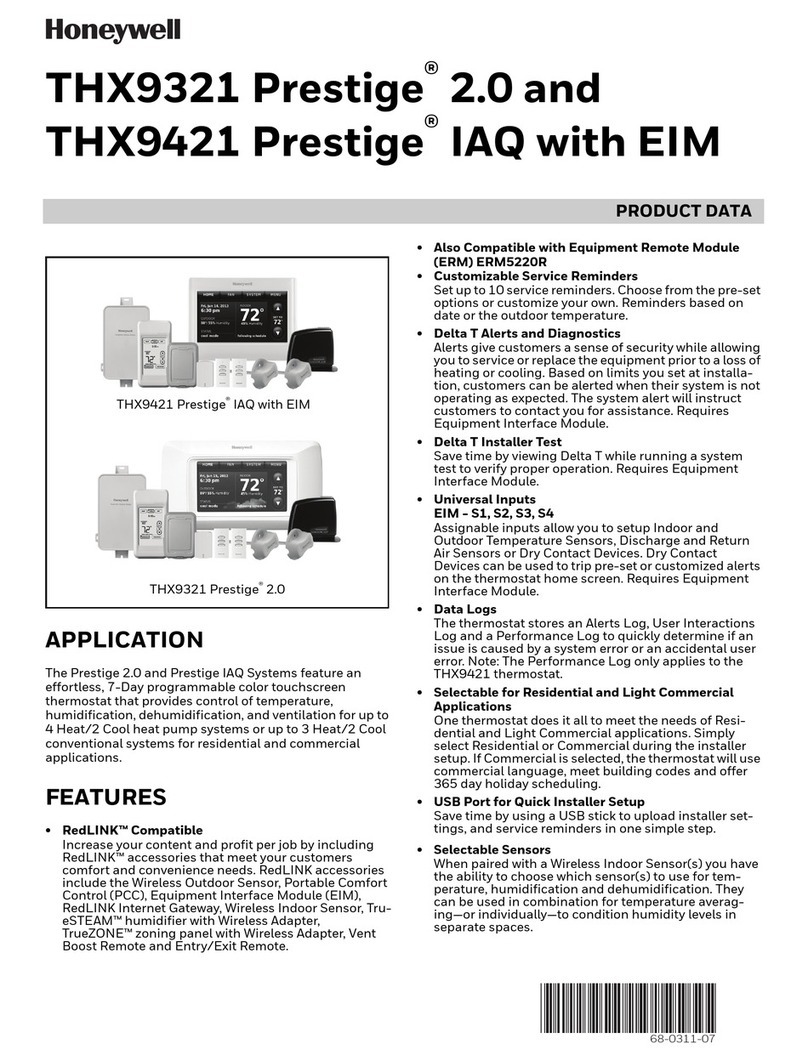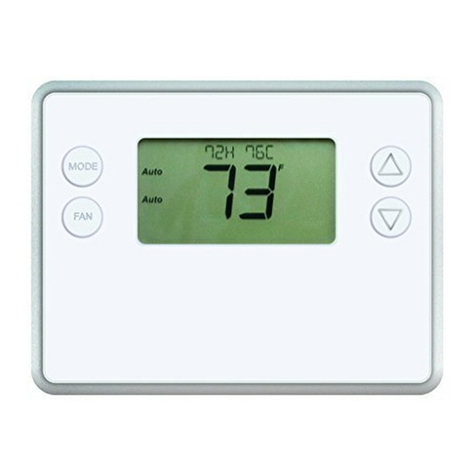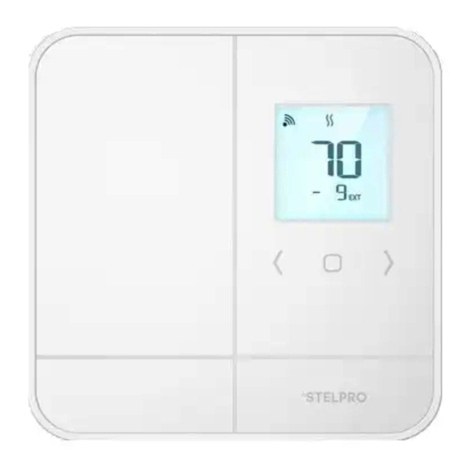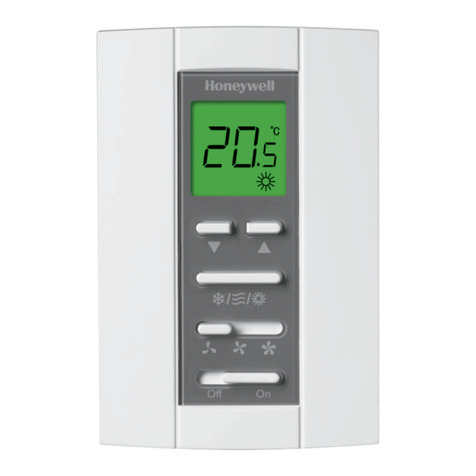This thermostat can be used with most 24 volt: gas, oil, Millivolt, electric heating and cooling systems,
including heat pumps with an aux/emerg heat element.
It cannot be used with: 120/240 volt heating elements (without a transformer), or on heat pumps that
have two compressor stages (Y2). Ask your dealer for other PurePro®thermostats to control those
systems.
This sheet contains basic installation steps and setup instructions. There are additional topics covered
in greater detail, such as adjustable set temperature limits, keypad lockout, and the air filter monitor, in
the full version of the instruction manual for this thermostat product. The full PDF version of this
manual can be downloaded at http://www.luxproproducts.com. Click on SUPPORT, then INSTRUCTION
MANUALS (LUXPRO®“P722Uc”).
• The thermostat requires batteries to operate and failure or sub-standard performance of the batteries
may impair or prevent the correct operation of the thermostat. Use Duracell®or Energizer®alkaline
batteries ONLY for all PurePro®thermostats requiring batteries. BE SURE TO CHANGE THE BATTERIES
AT LEAST ONCE A YEAR, or whenever you see the LO BATT indication on the screen. Failure to follow
these battery instructions could result in property damage and/or personal injury.
• The electrical rating for this thermostat is 1.5 Amps per terminal, with a maximum total load of 3.0A
for all terminals combined.
• The thermostat contains parts that may wear out through use and are susceptible to failure if over-
loaded or used in a manner other than as indicated in the documentation.
• Check unoccupied residences regularly to ensure that all systems are operating properly.
• Check any heating/air-conditioning system including this product before operation and at regular
intervals.
• Electrical interference, static electricity, failure or substandard performance of batteries, wiring
defects in the installation and/or characteristics of the connected HVAC devices may prevent the
system from regulating heating and cooling as anticipated.
• The thermostat is a sensitive device and dropping the product can cause damage to critical
components. If the product is dropped or shaken violently during transport or installation then it
should be replaced immediately.
• Persons with physical or mental limitations may not be able to promptly respond to a malfunction of
the heating/air-conditioning system.
• All residents should be made aware of the potential in any system for malfunctions that could cause
continuous heating or cooling and should be familiar with the operation and location of the
heating/cooling appliance on/off switch.
• Read the instruction manual completely before installing the thermostat. A more detailed product
manual is available on our www.luxproproducts.com website. You should consult a qualified HVAC
technician or an electrician if you do not fully understand the installation instructions.
1. Turn OFF the electricity to all heating and cooling components. Do not turn the electricity back on
until all work is completed.
2. Write down the letters printed near each wire terminal that is used, and also the color of each wire
that is connected to it. Self-adhesive wire labels are also enclosed.
3. Carefully remove the wires one at a time, and bend them in a manner so that they do not fall back
inside the wall. Do not allow bare wire ends to touch each other.
Use the wiring diagrams shown on the back of this installation sheet to find the closest match to your
particular heating and/or cooling system. Please read ALL of the Wiring Diagram Notes that are shown
above the connection diagrams, to avoid causing damage to your system or the new thermostat.
1. Strip wire insulation leaving only 3/8 in. (9.5mm) bare wire ends, and clean off any corrosion
present.
2. Fill the wall opening with non-combustible insulation to prevent drafts from affecting the
thermostat’s normal operation.
3. Route the wires through the opening in the new thermostat base plate, and install the mounting
screws.
4. If the previous holes cannot be used, hold the thermostat base against the wall so that it appears
straight and level (position the base for best appearance) and mark for the new screw holes. Attach
the base to the wall using the screws provided (use the supplied plastic anchors if needed when
mounting to a soft material such as drywall).
5. When attaching the wires to the thermostat, please ensure that the bare wire ends are held ALL the
way into the terminal block while the screw is being tightened, and be careful not to over tighten
them, as they only need to be snug.
INSTALL BATTERIES INTO THERMOSTAT: Install two brand new Energizer®or DURACELL®“AA” size
alkaline (only) batteries, into the thermostat’s battery compartment. Ensure the batteries are installed
in the proper direction.
HEAT / OFF / COOL, SYSTEM MODE SWITCH: Set this switch to HEAT to control your heating system,
and COOL to control your cooling system. The OFF position will disable both the heating and cooling
units.
AUTO / ON, FAN MODE SWITCH: When in AUTO, the blower fan (if present in your system) will cycle on
and off only while heating or cooling. In the ON position, the blower fan will run constantly at all times
with or without a demand for heating or cooling.
MULTI-FUNCTION, SET SLIDE SWITCH: This provides easy access to common settings, and should
always remain in RUN unless a specific item is being adjusted. NOTE: when thermostat is set to
“Manual” non-programmable mode, all 5 switch positions will act like RUN, except the “FILT/ENRGY”
position.
UP / DOWN BUTTONS: The UP and DOWN buttons are used to control the set temperature, or adjust any
other on-screen items. Typically, an item that is flashing can currently be adjusted.
HOLD BUTTON: This button activates and deactivates the manual Temperature Hold feature, which
maintains a fixed set temperature indefinitely without following a program routine.
SETBACK BUTTON: This button activates and deactivates the SETBACK feature, which overrides the set
temperature for an adjustable duration. This feature is described in greater detail in the ADVANCED
FEATURES section of the full user manual, which can be downloaded from our website (described
further below).
EMER BUTTON: For Heat Pump systems: this button activates Emergency Heat mode and prevents the
outdoor unit from running. For conventional (non-Heat Pump) systems, this button will have no effect in
Normal RUN mode.
NEXT BUTTON: This is used when setting items such as software options, and temperature programs.
When items on the screen are flashing during adjustments. Pressing the NEXT button will cycle through
which item is flashing.
Setup options for how the thermostat will function, along with choosing your particular system type, are
performed using a menu on the display screen.
TO ACCESS THE SETUP MENU: Move the System Mode switch into the OFF position, and then hold
down the EMER button for approximately 5 seconds until the screen changes. The menu will always
start with item #1, and is advanced to each following item by a single press of the NEXT button. The
options for each item are changed using the UP or DOWN buttons.
ITEM #01 (CLOCK FORMAT): [12Hr, default] This displays the clock times using standard AM and PM
values. [24Hr] This displays the clock times using the military-time format (example 22:00 hours,
without using AM or PM).
ITEM #02 (TEMPERATURE SCALE): [F, default] Shows all temperature values in Fahrenheit.
[C] Shows all temperature values Celsius.
ITEM #03 (THERMOSTAT TYPE): [PROGRAMMABLE, default] Use this setting for following a daily
program routine. [MANUAL] This setting omits the program routine and operates as a manual style non-
programmable thermostat. This is very basic and only shows the room temperature and set
temperature on the screen, with no clock.
ITEM #04 (PERIOD QUANTITY): [4P, default] Thermostat uses four periods per day (called MORN, DAY,
EVE, and NITE). [2P] The thermostat uses two periods per day (called DAY and NITE).
ITEM #05 (EARLY RECOVERY): [OFF, default] Program Set Temperature values start to occur at exactly
the period start times. [ON] Early Recovery affects how the transition occurs when changing from the
NITE to the MORN period, and when changing from the DAY to the EVE period. The thermostat
calculates how long it takes for your home to recover from a setback on a daily basis, and turns on
ahead of time in order to reach the target set point of the next upcoming program period by the period’s
start time. While in a recovery, the word “RECOV.” will be shown on the display screen.
ITEM #06 (SYSTEM MODE): [FURN, default] This is for the majority of heating systems that are not Heat
Pumps, such as a gas furnace or hot water boiler. [HP] Use this setting if you have a Heat Pump
system, which uses the outdoor unit as the primary heat source and may also contain an electric
heating element as a backup heat source.
ITEM #07 (FAN “G” TERMINAL OPERATION): This setting changes how your system’s blower fan (if
applicable) is controlled while the thermostat is in HEAT or EMERG HEAT mode, when the Fan switch in
the AUTO position. This setting does not affect the fan operation while in COOL mode. When ITEM #06
is set to "HP", this option is automatically set to "ELEC" and is not present in the settings menu.
[GAS, default] The blower fan is controlled solely by the heating system itself. Systems that would
typically use the “GAS” setting would be: natural gas, propane, or oil furnaces, and boilers. [ELEC] The
blower fan is controlled directly by the thermostat. This setting is required for heating systems that do
not control their own fan, such as HEAT PUMPS, and units that only have an electric-resistive heating
element as the heat source.
NOTE: If your blower fan does not operate properly after installation, try changing the GAS / ELEC option
to the “ELEC” setting.
ITEM #08 (DELAY TIME): [5, default] Thermostat waits 5 minutes before turning the system back on
after it was last run. This internal delay prevents rapid cycling and provides equipment protection. The
5 minute setting is fine for most applications. [2] Same operation as above but reduced to 2 minutes
between state changes.
ITEM #09 (TEMPERATURE SWING): A thermostat works by turning your heating or cooling system on
and off whenever the room temperature varies from the desired set-point temperature. The amount of
this variation is called the swing.
Use the UP/DOWN buttons to change the number value between 1 and 9. Generally your system should
cycle on about 3 to 6 times per hour. A smaller swing number makes the system cycle more frequently,
so the room temperature is more precise and constant. A larger swing number will make the system
remain on for a longer duration each time and decreases the number of cycles per hour.
ITEM #10 (STAGE-2 OFFSET): [2, default] This setting is adjusted as a number from 0 to 9. When set to
0 (ZERO), the second heating stage is completely disabled while in regular Heat mode (however
Emergency Heat mode will still function for heat pump configurations). An Offset value from 1 to 9
degrees will determine the number of degrees from the set point that will be required for the second
heating stage to turn on. This setting can be used to conserve energy in situations where the second
heating stage is more costly to operate when compared to the first stage.
Place the Set Slide Switch into the DAY/TIME position. With the day flashing, press UP or DOWN to set
the day of the week. Press NEXT and the clock time will start flashing. Use UP or DOWN to set the
time, making sure the AM/PM indication is correct. Holding the UP or DOWN buttons will make the
clock digits scroll rapidly. Return the Set Slide switch to the RUN position when finished.
Basic operation of your heating or cooling system can be obtained with the Set Slide Switch in the RUN
position and choosing either HEAT or COOL on the System Mode switch. The temperature can be
adjusted using the UP and DOWN buttons. When the thermostat is first powered up, it will follow a
default temperature routine that is preset from the factory. Alternatively, you can use the HOLD button
to maintain a fixed Set Temperature.
53580
WARNING: Use Energizer®or DURACELL®Alkaline Batteries Only.
Energizer®is a registered trademark of Eveready Battery Company, Inc.
DURACELL®is a registered trademark of The Procter & Gamble Company
PRODUCT INSTALLATION MANUAL
REMOVAL OF OLD THERMOSTAT:
CAUTIONS AND WARNINGS:
SYSTEM COMPATIBILITY:
INSTALLATION OF NEW THERMOSTAT:
SET DAY AND TIME:
COMPLETE THE INSTALL:
SYSTEM CONFIGURATION AND SETUP OPTIONS:
FRONT PANEL CONTROLS:
© 2014 LUX PRODUCTS CORPORATION. ALL RIGHTS RESERVED
IMPORTANT!
• Label every wire terminal designation on your existing thermostat wiring before removing
your old thermostat.
• Ignore the color of the wires since they may not comply with any standard. Please
connect wires using the terminal letter designations.
BASIC HEATING AND COOLING OPERATION:
DOWNLOAD FULL INSTRUCTION MANUAL FROM OUR WEBSITE:
PurePro®DP722Uc
7-Day Universal Thermostat
(Programmable or Non-Programmable)
PurePro®, Amherst, NH 03031 - An F.W. Webb Company - pureproproducts.com

